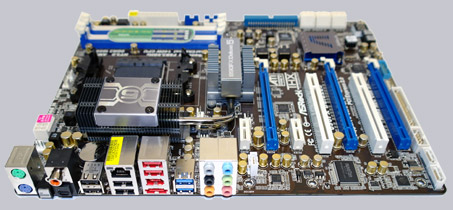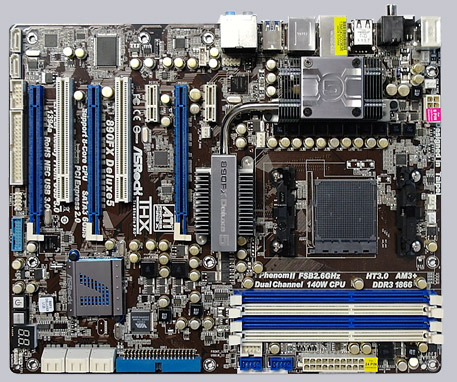
Result and general impression
++++ The ASRock 890FX Deluxe5/A/ASR motherboard has a price of approx. 140 Euro (05/2011) and is thus already in the upper price segment of the Socket AM3+ motherboards.
This ASRock 890FX Deluxe5 is the first AMD Socket AM3+ motherboard tested so far here at ocinside.de
It is based on the AMD 890FX chipset with SB850 southbridge and is except a few points very similarly build, like the already tested ASRock 890FX Deluxe AM3 predecessor.
The new ASRock 890FX Deluxe5 AM3+ motherboard has also five PCI Express slots, four USB3.0 ports, whereby two of them can be connected with the enclosed USB3.0 front panel/back panel, six SATA3 connectors provided by SB850, two additional SATA3 ports provided by a Marvel SE9120 chip, one eSATA3 connector, one conventional IDE port, Floppy port, Gigabit LAN, six analog sound connectors, digital optical and coaxial SPDIF sound output.
It offers a lot of additional features like e.g. the integrated fan controller and the new UEFI BIOS, which is updated for the test to UEFI BIOS version P1.40.
In this nice cardboard box the ASRock 890FX Deluxe5 AM3+ motherboard is delivered:
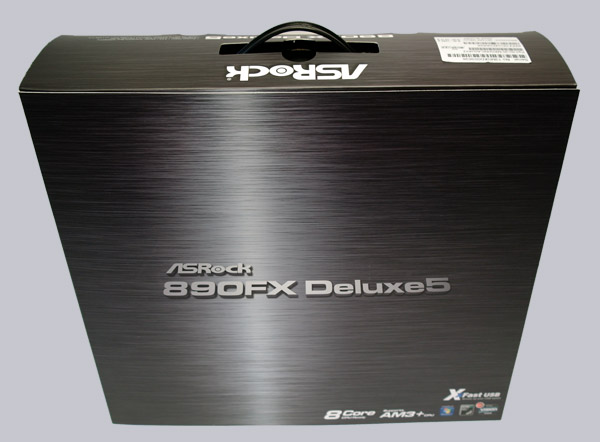
Who like to, can flip up the new designed cardboard box:
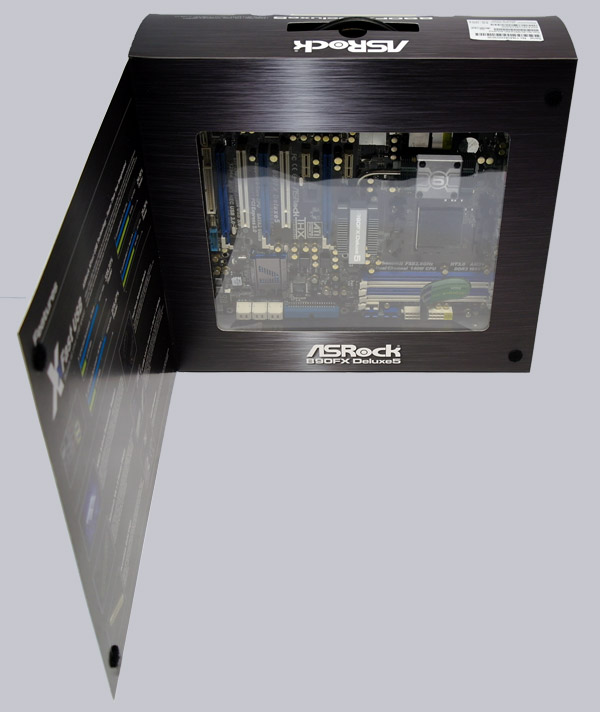
The board was not packed in an additional air cushion foil and lies relatively unprotected in the cardboard, thus it should be transported as carefully as possible.
The layout and the finish of the ASRock 890FX Deluxe5 board makes a very high-quality impression and is build like the 890FX Deluxe4 board with high-quality solid caps capacitors, 7-segment post code display, LED lighted Power, Reset and Clear CMOS button:
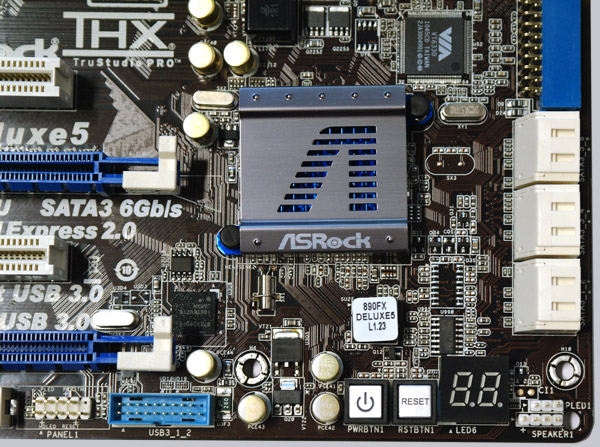
Equipment and other features …
The ASRock 890FX Deluxe5 motherboard came with a manual, the above mentioned software setup guide, one DVD, four SATA data cables, two SATA power cables, one floppy cable, one IDE cable, one 3.5″ USB3.0 frontpanel with a slot bracket for optional mount at the PC rear, one ATX I/O shield and one chipset fan with srews and tool for optional installation.
Here is a picture of the included equipment:
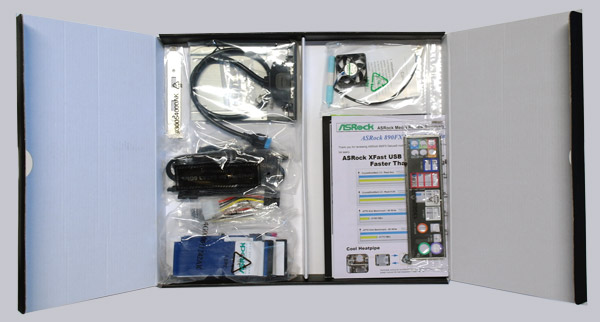
Expansion cards …
This 3-Way CrossFireX motherboard offers three PCI Express 2.0 video card slots, whereby either one Radeon video card can operate with x16 band-width, or two can operate in x16 mode, or two in x16 mode and one in x4 mode.
A SLI/XFire switch card is not necessary to get the optimal performance for single, CrossFireX or 3-Way CrossFireX operation.
If one like only use one video card on the 890FX Deluxe5, one should insert the PCI Express video card into the blue PCIe2 slot, in order to get the fastest x16 bandwidth.
By the way one could use theoretically also several nVidia video cards, however officially not as SLI, but only the output to several monitors would be supported.
Additionally to the three PCI Express 2.0 slots there are two PCI slots and two x1 PCIe 2.0 slots, whereof one PCIe slot can be upgraded with a short card and the other with a full-size PCIe card.
Memory …
The ASRock 890FX Deluxe5 can be equipped with up to four DDR3 modules and is expandable depending upon operating system used (see list) to maximally 32 GB memory.
The Socket AM3+ motherboard supports DDR3 memory modules and can be optimized in the BIOS for DDR3-800, DDR3-1066, DDR3-1333 or DDR3-1600 and faster Dual Channel modules.
DDR3-1800, DDR3-1866 or higher clock-rates are currently only possible with overclocking.
Hard disk drive connectors …
The 890FX Deluxe5 offers, contrary to the previous tested 890GX motherboards, one floppy connector and one IDE connectors for up to two conventional ATA-133 drives.
Furthermore this 890FX Deluxe5 board offers with the AMD SB850 chipset six bent SATA3 connectors (6 Gb/s), with the additional Marvel 88SE9120 chip two more SATA3 connectors (6 Gb/s) and one eSATA3 port integrated in the I/O panel.
The six S-ATA3 ports supports RAID 0, RAID 1, RAID 0+1, RAID5, NCQ, AHCI and the Hot Plug function in AHCI mode (AHCI stands for Advanced Host Controller Interface).
The manual and the included DVD contains all basic information to manage a new installation of Windows XP, Windows Vista or Windows 7 with S-ATA3 hard disk drives, and how to make a RAID installation.
32-Bit and 64-Bit drivers for Windows XP, Windows Vista and Win7 are provided on the DVD and can be downloaded on the ASRock support page.
The UEFI BIOS support drives with more than 2TB for a Windows 7 x64 or Vista x64 installation.
USB and Firewire …
The board has two USB 3.0 connectors on the ATX-panel and another 20-pin connector for the enclosed front USB3.0 panel with two additional USB3.0 connectors.
Very practicable: Depending upon desire the front panel can be converted over the empty slot bracket provided to a back panel, in order to be able to use the USB3.0 ports at the rear side of PC chassis.
Furthermore, it offers six USB 2.0 connectors on the ATX panel and four internal USB 2.0 plugs for up to eight optional USB ports.
So ASRock utilize the latest USB3.0 technology with up to 5 Gb/s and all USB 2.0 ports of the chipset.
Hint: One should install the new ASRock XFast USB software to accelerate the USB transfer rate e.g. for USB sticks clearly.
Additionally, the board has one IEEE1394 Firewire port on the I/O panel and another optional internal IEEE1394 port.
ASRock integrated two NEC D720200F1 controller ICs on this 890FX Deluxe5 to provide the front USB 3.0 ports in addition to both USB 3.0 ports on the I/O panel:
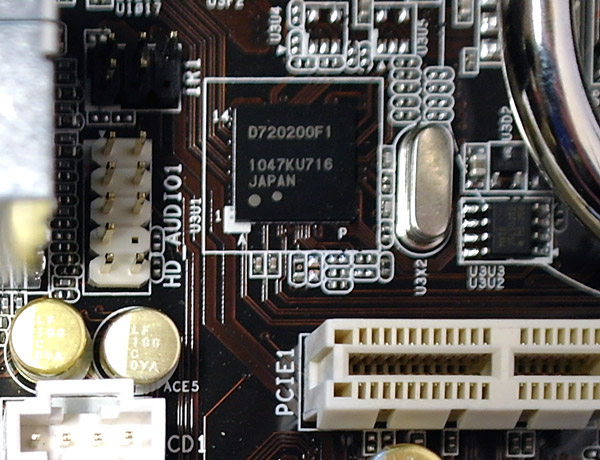
Network …
The Realtek RTL 8111E chip is integrated on the ASRock 890FX Deluxe5 motherboard and offers a 10/100/1000 network connector on the ATX panel.
The LAN connection is WoL capable, offers LAN cable detection and supports energy efficient 802.3az ethernet.
Serial and parallel port …
This motherboard does not provide a parallel port.
The serial port is only optionally available as internal onboard connector.
Sound …
The ASRock 890FX Deluxe5 motherboard is equipped with the ALC892 audio codec with content protection, which supports 7.1 surround sound for example analog over 6x 3.5mm connectors on the ATX panel or over an internal audio connector.
For the digital output there is an internal HDMI SPDIF out connector available, to connect it for example with a SPDIF cable to a HDMI suited video card, in order to get the digital audio and video signal to a HDMI equipment like a HD-Ready LCD TV.
Additionally there is also an coaxial digital SPDIF output, an optical digital SPDIF output, premium Blu-Ray audio support and THX TruStudio Pro support.
So most users don’t need to buy an additional sound card with digital outputs.
ATX backpanel connectors …
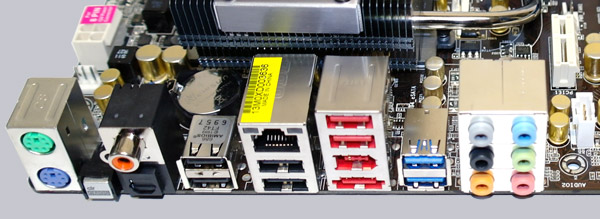
From left to right one can see 2x PS/2 connector for PS/2 keyboard and PS/2 mouse, LED lightning Clear CMOS button, coaxial and optical SPDIF out, 2x USB 2.0 ports, RJ45 Gigabit LAN and 2x USB 2.0 ports, 2x USB 2.0 and IEEE1394 and eSATA3, 2x USB 3.0 and 6x 3.5mm jacks for analog sound.
BIOS and Overclocking …
Let us continue with BIOS options and BIOS overclocking.
By pressing F2 or Del, you get access to the AMI BIOS with all important hardware settings.
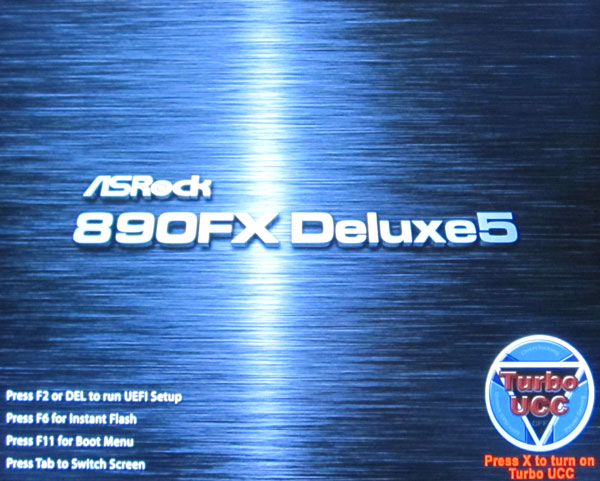
ASRock replaced the conventional BIOS on the 890 FX Deluxe 5 with the UEFI Setup.
New above all is the graphical surface of the UEFI BIOS, which permits an operation with the mouse, but although depending upon desire can be controlled also only with a keyboard.
USB mouse and USB keyboard user should not deactivate the Legacy USB support in the BIOS with the USB Configuration, because otherwise they can’t access the UEFI Setup.
In the Auto mode the board decides if the USB device need to operate in Legacy mode.
Here is a screenshot of the new graphical UEFI BIOS surface:
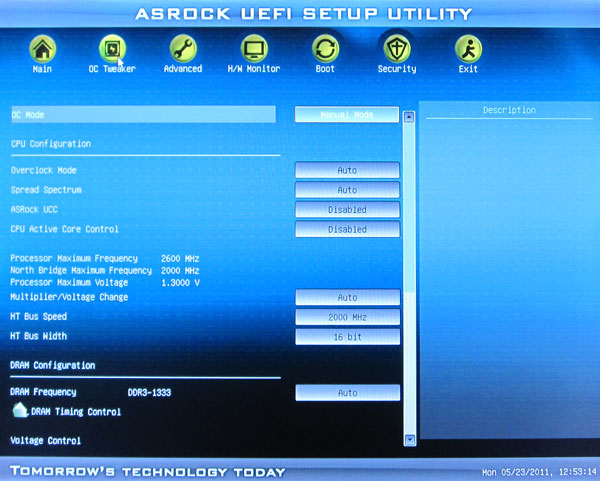
ASRock offers a very comfortable option to flash BIOS updates.
By the so-called ASRock Instant Flash option in Advanced BIOS or by pressing F6 during the PC start one can get into the ASRock Instant Flash utility.
Hereby one can very easy upgrade a downloaded ASRock BIOS without further boot CD, boot stick, boot disk, etc. Just start the ASRock Instant Flash utility.
Then select a BIOS Flash ROM from any FAT formatted device like an USB Stick to flash the BIOS without another boot medium.
At review date, the latest UEFI BIOS version was P1.40, which we updated of course with the comfortable Instant Flash Tool.
The latest at test date available P1.40 BIOS version offers very comprehensive DDR3 memory settings like e.g. the memory frequency setting from 400 MHz over 533 MHz and 667 MHz on up to 800 MHz (DDR3 800/1066/1333/1600).
The frequency of all memory modules is calculated and shown after changing the reference clock and makes it much easier to adjust the right RAM frequency.
The host clock is adjustable from 150 MHz up to 500 MHz, the HT (hypertransport) frequency
is adjustable from 1x to 10x (200 to 2000 MHz) and the NB frequency multiplier can be adjusted between 5x and 10x.
The PCIe frequency is adjustable from 75 MHz up to 250 MHz.
Changes to the CPU frequency is immediately shown in the BIOS, so if you change for example the reference clock, you will see how high the CPU frequency would be with each divisor on this setting.
In our tests, it was possible to overclock to a very high 300 MHz reference clock.
Some may think that the reference clock is no longer important for overclocking of e.g. Black Edition processors with unlocked multiplier, but the reference clock is still important for PC overclocking.
At least when one buy high-end OC RAM and like to operate it on the maximum frequency, because this is on most boards only possible with reference clock increasement.
And of course not every user like to spend more money for these AMD BE CPUs.
The boot failure guard was checked in this review as well and it was possible to start the PC on standard values with too high overclocking settings without using the Clear CMOS Jumper.
It was just necessary to press the Reset button.
ASRock integrated an “Boot Failure Guard Count” option, where the user can decide, how often the board should try to start with too high settings, before it reduces the settings for a correct boot.
Another interesting feature is the so-called UCC BIOS setting.
With the Unlock CPU Core feature it was possible to unlock deactivated CPU Cores.
Unfortunately it’s not possible with every AMD Athlon II or Phenom II CPU, but the BIOS options are nevertheless present and this is surely for some buyers an important purchase aspect.
The UCC option was called Advanced Clock Calibration or short ACC on previous motherboards and can be unlocked on the ASRock board also without the additional UCC IC.
The L3 Cache allocation (BSP and All Cores) couldn’t be changed with the P1.40 BIOS, contrary to the previous 890FX Deluxe4 board.
But the CPU Active Core Control option can be useful to activate or deactive some Cores of the CPU and additionally it is possible to optimize each CPU Core in the BIOS manually.
Furthermore, this board offers a Vcore setting on the Phenom II test CPU from 0.6000 Volt to 1.7500 Volt, a CPU NB voltage from 0.6000 Volt to 1.7500 Volt, a NB voltage from 1.110 Volt to 1.795 Volt, a HT voltage setting from 1.105 to 1.390 Volt and a few more settings to reach better overclocking results on this platform.
The DDR3 memory voltage can be set between 1.250 Volt up to 2.065 Volt, which should be enough power for most DDR3 OC RAM modules.
Who don’t know all of these settings or who don’t like to know more about overclocking, can try to overclock the PC over the CPU OC mode menu.
In the CPU OC mode one can increase the system performance automatically up to 50% if the components support it with the necessary luck.
Just select the desired increasement setting on the OC Tweaker page and some components of the system will be overclocked up to 50 percent (better start with a lower value and not with 50% …).
With the CPU Thermal Throttle option, it is possible to lower the CPU frequency on too high internal CPU temperature in the range of 12.5% to 87.5%, to protect the CPU from overheating.
This is just a protection, of course it’s necessary to select a good cooling for overclocking.
As special BIOS feature one can store different BIOS settings with a desired name.
Thus one can save for example balanced BIOS settings, overclocking settings and underclocking settings in a user profile of the BIOS to load them very quickly at any time.
BIOS Undervolting …
The downclocking or underclocking was also tested in this review.
It was possible to lower the AMD Phenom II 710 CPU multiplier over the BIOS to 8x and the processor can be underclocked in such a way with 150 MHz reference clock to approx. 1200 MHz.
Underclocking and OverClocking is outside of the manufacturers specification, so it’s necessary to have a bit luck and ASRock gives several options to overclock or underclock the system more easily.
The BIOS of the passive or optional active cooled 890FX Deluxe5 motherboard offers a CPU Quiet Fan option (temperature fan control) for a 4-pin CPU fan, a 3-pin CPU fan and a 4-pin chassis fan.
Also the other chassis fans can be adjusted manually, so it is not necessarily to buy an additional fan controller.
Power consumption …
Power consumption will vary depending upon the hardware and upon the PC load.
The current consumption of the test PC with AMD Phenom II 710 X3 CPU, 4GB DDR3-1333 memory, hard disk drive and Cooler Master Silent Pro M 600W test PSU was without overclocking depending upon load:
– With Gigabyte GTS250 card the power consumption was between116W and 198 Watt.
– With Sapphire HD4870 video card the power consumption was between 145W and 238 Watt.
Thus, the maximum power consumption is a little bit higher and the Idle power consumption is lower than the 890FX Deluxe4 current consumption.
In our test it was also possible to overclock with activated CnQ feature.
The temperature monitoring and overclocking features can be e.g. adjusted with the included ASRock Extreme Tuning Utility Software.
Result …
The ASRock 890FX Deluxe5 AMD Socket AM3+ DDR3 motherboard already support Socket AM3+ processors, has like the 890FX Deluxe4 a Deluxe equipment, exemplary build quality and achieve good overclocking results.
The basic equipment of this Deluxe motherbaord is really “Deluxe”, because the 890FX Deluxe5 offers six SATA3 ports with RAID support over the SB850, two additional SATA3 ports over the Marvel SE9120, one eSATA3 connector, two USB 3.0 ports on the I/O panel, two USB 3.0 front panel or back panel ports, up to ten possible USB 2.0 ports, two possible IEEE1394 ports, Gigabit LAN, 7.1 sound, analog sound output over six connectors, digital sound output over an optical SPDIF connector and one coax SPDIF connector.
Contrary to the 890GX boards, this board does not provide an onBoard graphics solution, but it offers a floppy disk connector as well as a conventional IDE connector for up to two ATA133 drives.
The new graphic UEFI BIOS interface can be controlled well over keyboard and mouse or also only by keyboard.
The operation in some points takes getting used to, but the UEFI BIOS looks not only more stylish, but support depending upon operating system also drives over 2TB.
The maximum overclocking results were with the reference clock in overclocking test with up to 300MHz somewhat below the 890FX Deluxe4 pendant (up to 330MHz), but the maximal possible overclocking result can vary.
All in all the ASRock 890FX Deluxe5 is a great choice for users and enthusiasts, who like to build a high quality PC with optimal support of the AMD AM3+ processor generation.
Here you can buy the ASRock 890FX Deluxe5 motherboard.
* All Socket AM2 / AM3 PCIe motherboard reviews since 01.07.2010 are based on
1x Gigabyte GV-N250OC-1GI Nvidia GTS250 PCI Express 2.0 video card,
2x Sapphire HD4870 512MB ATI Radeon HD4870 PCI Express 2.0 video cards,
2x 2048MB Crucial Ballistix Tracer DDR3-1333/PC3-10600 memory modules,
Cooler Master Silent Pro M 600W power supply unit and the following software configuration:
Microsoft Windows 7 Ultimate, Microsoft Windows Vista Ultimate, Windows XP SP2, SiSoftware Sandra 2010c,
Futuremark 3DMark03, 3DMark06 and 3DMark Vantage (the software is available in the Links & Downloads section).
All benchmark results only offer a comparison among themselves for a rough motherboard performance comparison.


